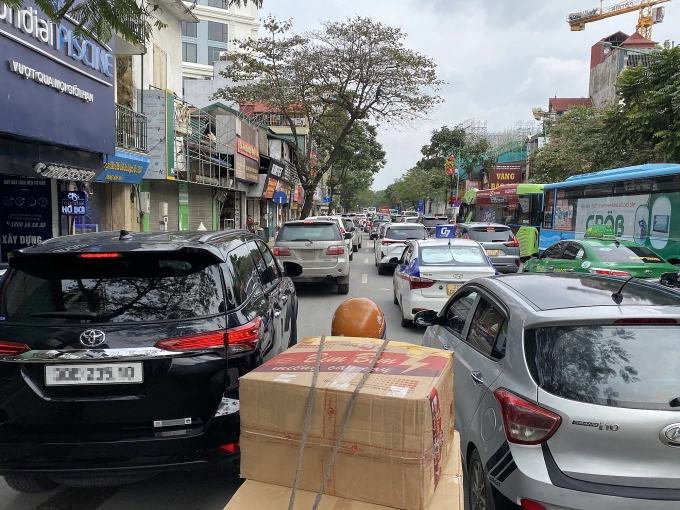For nearly a month now, going to work has become a nightmare for Minh Phuong: it takes 2-3 hours to travel the 15km between her home and office every day.
If the road is clear, it takes 30 minutes for her to get to work. During rush hour or bad weather, it takes about 1.5-2.5 hours to pass through the worst traffic spots, like Truong Chinh Street, Nga Tu So Street, and Lang Street.
But as the Tet (Lunar Year Festival) approaches, Phuong, 27 from Hai Ba Trung District, spends more than three hours on a single trip, because all the roads are jammed in all directions. Tet, Vietnam’s biggest and most important festival, will last from Feb. 8 to 14, 2024. The traditional festival will peak on Feb. 10.
“Instead of only being jammed in the early morning and late afternoon, all large and small roads in the city are packed with vehicles from 7 a.m. to 9 p.m.,” Phuong said. The jams caused her to arrive at work late every morning, costing her a fine of VND100,000 ($4.1) each time.
 |
|
Motorcyclists navigate sidewalks to circumvent traffic jams. Photo by VnExpress/ Pham Chieu |
As the marketing manager for a stone import-export company in Cau Giay District, Hong Hanh, 35 years old, living in Long Bien District, has to attend many important meetings. But a lot of times, when meeting time has started, she would still be stuck on the overpass 2 km from the company, forcing Hanh to stop at a coffee shop to switch to an online meeting.
In particular, traffic congestion in the last months of the year on main roads in many central districts have caused Hanh to be late for appointments with business partners on several occasions, causing her to be scolded by her boss.
“It’s barely 1-2 pm on weekdays but many big streets like Kim Ma, Nguyen Thai Hoc, and Phan Boi Chau are lined with cars, and motorbikes have to either go on the sidewalk or get stuck in one place. Going out at the end of the year is like going to war because you have to calculate your path and avoid going too deep – making it difficult to turn back,” Hanh said.
Congestion throughout the city make shipper Huu Nghia, 45 years old, afraid to go out. In previous months, he only needed to arrange his schedule to avoid rush hour and particularly difficult traffic spots, but now “there is no way to avoid it.
“I always try to wriggle out of the crowd of vehicles, but I’m always 30 minutes to an hour late delivering goods to customers. Not to mention on rainy days, being a few hours late is normal,” said the native of northern province of Hung Yen.
 |
|
Kilometer-long traffic jam on Nguyen Thai Hoc Street, Dong Da District, captured at 2:00 p.m., Jan. 25, 2024. Photo by VnExpress/Quynh Nguyen |
Traffic jams regardless of time of day during the Tet holiday are a concern for many people in the capital. Every social media post about this situation attracts thousands of comments. Every time the weather changes, the number of image posts of people stuck on the road increases sharply.
Dr. Phan Le Binh, a lecturer in the Construction Engineering Program at Vietnam Japan University (Hanoi), said the situation is not new, and that traffic problems at the end of the year come from five main causes.
One is the increased need to travel to shop and give gifts to people in and outside of the city.
Second, there are many trucks carrying bulky Tet goods for distribution in the city.
Third, people flock to the streets to buy plants and Tet items sold on the sidewalks, leaving their vehicles parked illegally and clogging the streets.
Fourth, at the end of the year, many routes are in the middle of maintenance – further decreasing the amount of drivable space on roads. Finally, many drivers do not obey traffic laws, and often drive on sidewalks, encroaching on public transport lanes, and disobeying traffic controller’s instructions.
In addition, traffic expert Nguyen Xuan Thuy, former director of Transport Publishing House, said high population density and urbanization are the causes of congestion.
Thuy said that Hanoi currently has over 8 million registered vehicles including 1.1 million cars, 6.7 million motorbikes, and 200,000 electric bicycles, not to mention 1.2 million out-of-province vehicles. Meanwhile, the proportion of land reserved for traffic in the city is only 12-13% compared to the standard of 20-26%.
According to Director of the Hanoi Department of Transport Nguyen Phi Thuong, the number of personal vehicles has increased by 4-5% in recent years, but the growth speed of transport infrastructure development has been only 0.6%, causing Hanoi to “always be chasing but never managed to reach its goal.”
A new report from the Hanoi Department of Transport also shows that the traffic density on many Hanoi roads exceeds their intended design by 6-8 times. For example, Le Van Luong – To Huu Street’s traffic density is 1.1-1.7 times its design; Chuong Duong Bridge is 8 times; Nguyen Trai Street, in Thanh Xuan District, which is about 3.4 km long, has a traffic density of 3.3-5.6 times its design during rush hours.
Statistics from 2023 show that the city has 37 congestion points, 10 of which are newly formed and 27 were existing points from 2022.
 |
|
Disarrayed traffic congestion at the intersection of Nguyen Khang Street and Yen Hoa Bridge, Cau Giay District, in the afternoon of Jan. 24, 2024. Photo by VnExpress/Quynh Nguyen |
Bored with crawling inch by inch thru traffic, Hong Hanh persuaded her husband – who owns their house in central Hanoi’s Ha Dong District, to buy a smaller apartment in Cau Giay District.
“Even though the new place is small, I find it reasonable because my husband and I are close to work and the children’s school. There are also a lot of shortcuts nearby, allowing us to temporarily avoid congestion,” Hanh said. On days when she goes out to meet business partners, she leaves 1-1.5 hours early to ensure that she arrives on time.
It was difficult to relocate due to the nature of his job, so shipper Huu Nghia came up with the idea of delaying his delivery deadline until after 7 pm for non-urgent orders, which was approved by his store owners. For “express” packages, the 45-year-old man will research shortcuts and avoid main roads.
“Delivering goods in the evening will be more tiring because you have worked all day, the temperature has also dropped sharply, but the roads are clear and you can also save gas,” Nghia said.
To avoid causing inconvenience and fatigue to drivers, traffic expert Nguyen Xuan Thuy suggests some solutions such as upgrading infrastructure and making roads wider. In particular, public transportation must meet timing requirements and should arrive on time, alongside good service to stimulate more demands. We should not build too many apartment buildings in the city center, and we should invest in ways to open up more satellite cities to thin out population density.
Dr. Phan Le Binh, on the other hand, pointed out that not all individuals can use public transportation due to geographical location, and city routes are also hard to change in a short amount of time. Therefore, he said, the best way to minimize congestion during Tet is for the authorities to divert traffic and resolve potential jams. Arrange parking spots in areas with a high number of shops selling Tet items to avoid situations where vehicles are parked freely on the road, the doctor suggested.
“But the most important thing is to raise awareness among drivers about obeying traffic laws, provide more options to vehicles, and help avoid encroachment over traffic lanes…or risk creating more congestion,” he added.
Tired of having to travel through at least five serious traffic jams every day, Phuong decided to rent a room near her workplace before the Lunar New Year. Her new abode is more expensive, is deep inside a small alley, and has little to no amenities, but Phuong said she is still satisfied because it only takes 15 minutes to travel back and forth from her job. Every day when she comes home from work, she still has time to eat and rest.
- Reduce Hair Loss with PURA D’OR Gold Label Shampoo
- Castor Oil Has Made a “Huge” Difference With Hair and Brow Growth
- Excessive hair loss in men: Signs of illness that cannot be subjective
- Dịch Vụ SEO Website ở Los Angeles, CA: đưa trang web doanh nghiệp bạn lên top Google
- Nails Salon Sierra Madre
 VnExpress News The News Gateway of Vietnam
VnExpress News The News Gateway of Vietnam
